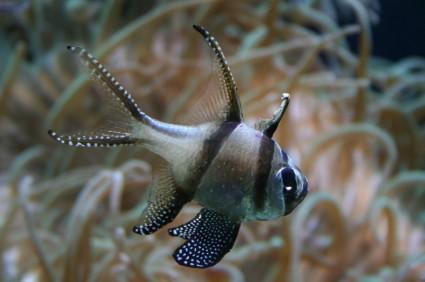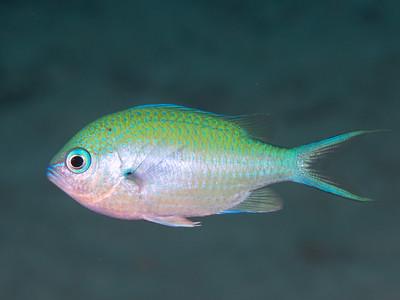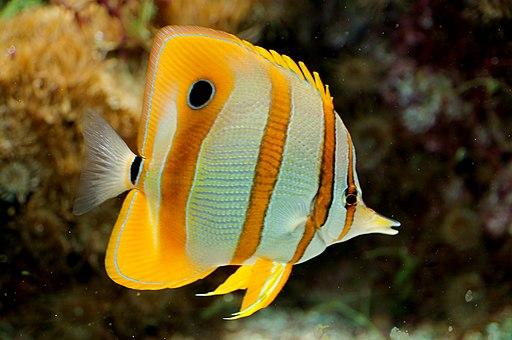The 10 Best Saltwater Fish for Beginners
By Matt Leighton, vivofish.com for aboutfishonline.com.
If you’ve never kept a saltwater tank, there’s a lot of research and planning that goes into it.
You’ll need to figure out what size tank you’d like, how to keep water parameters even, and how to introduce new fish to the community tank once it’s set up (it can be quite a lot of work if you do it right!).
They can be successfully kept in a reef tank. You should provide lots of live rock in their tank.
Today, however, we’ll focus on perhaps the most fun aspect of setting up a new tank: stocking it!
1. Captive Bred Ocellaris Clownfish

If you love Finding Nemo, then clownfish are sure to be at the top of your list of marine fish to keep in your home aquarium.
As with Nemo, the Ocellaris Clownfish is brilliant orange in color. It’s tail and fins are edged in white, followed by a black band, then orange for the main color. Appearance wise, it’s most distinctive feature are the vertical white bands edged in black.
- Care Level: Easy
- Tank Size: 20 gallon. These fish can grow up to 3” in length, so if you have several, a bigger tank would be better.
Pros: Ocellaris Clownfish are usually peaceful, reef safe, non-venomous creatures that are fairly easy to keep. Captive-bred fish tend to have an easier time adapting to a home aquarium and will increase your chance of succeeding with keeping them.
Cons: Even though clownfish are fairly peaceful, they will defend their eggs and nest from other creatures in the tank. You may need to separate them into a breeding tank or put a temporary partition up to avoid fighting. Other than that, clownfish usually need to be introduced to the tank as a group.
Overall Rating: 9/10
These are brilliant, attractive fish that are relatively easy to care for and can fit in smaller tanks. Since they are very popular with home aquarists, there is also a good bit of quality information available on how to care for them.
2. Captive Bred Azure Damselfish
This classically shaped bicolor fish sports a brilliant blue upper body. Then, starting behind the gills, the underside of this fish changes to mustard yellow that curves upward and extends into the tail.
- Care Level: Easy
- Tank Size: 30 gallon, since this fish rarely reaches over 2.5 inches.
Pros: This a hearty fish that will adapt to a wide range of water quality conditions. It is also an attractive fish that will consume flakes, pellets, and frozen food.
Cons: Once it gets older, this fish can become territorial. It also needs plenty of hiding places.
Overall Rating: 9/10
Because it is fairly tolerant of water chemistry problems, it is a good fish for beginners. As a captive bred fish, it is also ideal from an ecological perspective.
3. Captive Bred Kaudern’s Cardinalfish
Also known as the Banggai Cardinalfish, his is a decidedly unique looking fish with sharp, narrow fins and tail. It has a somewhat oval shaped, silver body with black vertical stripes that extend into the fins, and horizontal black stripes extending into the tail. It’s entire body and lower fins are dusted with white polka dots.
- Care Level: Easy
- Tank Size: 30 gallon
Pros: This captive bred fish readily accepts frozen foods and flake foods. It gets along well with other members of its own species and can be kept in a school.
Cons: Tends to be a slow swimmer that won’t be able to defend itself by outswimming aggressive fish.
Overall Rating: 9/10
This fish is fairly easy to care for, is captive bred, and has fascinating color patterns. This fish is ideal for beginners.
4. Black Axil Chromis
This beautiful, classically-shaped fish is blue-green in color with a white to silver belly. Overall, it is a stunning creature that compliments the colors of other fish and creatures in the tank.
- Care Level: Easy
- Tank Size: Minimum 30 gallon. Since this fish reaches almost 5” inches at maturity and does best in schools, a 50 – 100 gallon tank would be better to start with.
Pros: These are very peaceful fish that form schools easily. They are also long-lived creatures, and can go up to 15 years in a home tank.
Cons: Even though they will do fine in 30 gallon tanks, they also need to be kept in schools. If you have a smaller tank, you may only be able to fit one species in the available space.
Overall Rating: 9/10
These are beautiful fish that are easy to care for. They tolerate a wide range of frozen and flake foods. Since they form schools, psychologically they may be closer to some freshwater fish that you may already have experience with.
5. Naoko’s Fairy Wrasse
These stunning fish have horizontal red, yellow, and white stripes on their long, sleek bodies. These brilliant colors are edged with inky black fins and tail. If you are looking for a brightly colored fish that will easily stand out among other more colorful fish, Naoko’s Fairy Wrasse is an ideal choice.
- Care Level: Moderate
- Tank Size: Minimum 150 gallons and deep. Fill 75 to 100 gallons to allow for some jumping clearance.
Pros: The Naoko’s Fairy Wrasse is a relatively peaceful fish that does not have poisonous stingers. It will live peacefully with most other fish, tends to be hearty, and will tolerate frozen and pellet foods.
Cons: Since this fish was only discovered in 2008, it is still fairly expensive. The Naoko’s Fairy Wrasse is also known to be a prolific jumper, so you will need a tank with enough clearance at the top to put a tight fitting lid. As with other fish that tend to be powerful jumpers, the Naoko’s Fairy Wrasse can injure itself if it hits the lid too hard. You may also need a larger tank or a saltwater pond to manage this problem.
Overall Rating: 8/10
Overall this is a gorgeous fish that will enhance any saltwater tank. Other than being a powerful jumper, the Naoko’s Fairy Wrasse is fairly easy to care for and will do well in both coral and reef aquariums.
6. Griessingeri Goby
For its size (approximately 2” long at maturity), the Griessingeri Goby has a lot of colors. It has a long, brilliant white body with black spots all over its head and gill cover. Then, behind the gills, it has one vertical orange stripe, and a white fin with orange ringed black spots. It also has a thin, anterior fin that is much taller and brilliant orange in color.
- Care Level: Moderate
- Tank Size: 10 gallons. This fish would actually do well in a nano tank as well as in larger marine tank setups.
Pros: The Griessingeri Goby can be a bit shy, and will need plenty of hiding places. They can also be a bit more expensive than other marine fish, so you may want to develop your skills a bit before giving these a try.
Cons: Since this fish was only discovered in 2008, it is still fairly expensive. The Naoko’s Fairy Wrasse is also known to be a prolific jumper, so you will need a tank with enough clearance at the top to put a tight fitting lid. As with other fish that tend to be powerful jumpers, the Naoko’s Fairy Wrasse can injure itself if it hits the lid too hard. You may also need a larger tank or a saltwater pond to manage this problem.
Overall Rating: 8/10
This is an attractive fish that will fit into community tanks with some ease. At first, however, it can be shy, and will need good cover in order to feel safe.
7. Black Sailfin Blenny
This inky black fish has a long, curvy body and a decidedly square head. It is a magnificent fish that will serve as an accent to more brightly colored species.
- Care Level: Moderate
- Tank Size: 55 gallons, especially if you plan on keeping multiple species, as it reaches almost 5 inches long.
Pros: This fish is the premier algae eater for a saltwater tank. It is also fairly peaceful and will get along with fish from other species that are similar in size and psychology.
Cons: The Black Sailfin Blenny does not always get along with members of its own species. It is best to keep only one of this fish to a tank. If you want to breed this species, purchase certified breeding pairs and introduce them to the tank together.
Overall Rating: 8/10
This fish is beautiful, and will also provide a useful service while it gets its dietary needs met.
8. Captive Bred Orchid Dottyback
If you are looking for a splash of brilliant purple in a tank, this fish will suit your needs. It has a long, sleek body with compact fins and tail.
- Care Level: Easy
- Tank Size: 30 gallons, as they grow to about 3” long
Pros: This is a non-venomous, colorful fish that will feed on bristleworms and other creatures that are considered parasitic or pests in a marine tank.
Cons: This fish may be a bit aggressive towards smaller fish, and can also be territorial.
Overall Rating: 8/10
Overall, this is an attractive, hearty fish, however it may not get along with other tank mates.
9. Copperband Butterflyfish
Appearance wise, it is easy to see why the Copperband Butterflyfish is favored by many hobby aquarists. These fish have disc shaped silver bodies and a gracefully sloping long nose. Starting with their eyes, these fish have 4 copper and black vertical bands that extend through their top fin. They also have a black eyespot on the rear portion of their top fin, and a black vertical stripe at the base of their tail.
- Care Level: Difficult
- Tank Size: 50 gallon or larger
Pros: Exceptionally beautiful fish that will grow to an appealing size. These fish are also non-venomous, so they are a safe choice for aquarium keepers with children that might put their hands in the tank. They are also a good choice for advanced beginner to mid-level saltwater aquarium hobbyists that are ready for a bit more challenge.
Cons: Copperband Butterfly fish can be very shy and difficult to feed. While they are considered peaceful fish that get along well with other saltwater fish, they may not do well with other butterfly fish in the same tank.
Overall Rating: 7/10
These are beautiful fish that will grow to a decent size. They do pose some challenges insofar as feeding is concerned. You may need to use special foods or adjust the water chemistry in order to ensure this fish lives a long, healthy life in your aquarium.
10. Blueline Angelfish
A personal favorite of mine, these stunning fish have velvet blue, disc shaped bodies with brilliant horizontal blue stripes. They also have a brilliant yellow tail, a vertical yellow band behind their eyes that extends to their caudal fins, and a dash of yellow on their foreheads.
- Care Level: Moderate to difficult
- Tank Size: 250 gallons or more
Pros: Blueline Angelfish have stunning colors that will enhance any aquarium. They do not have venomous stingers which makes them safer for new and advanced aquarium keepers alike. Once established, they also tend to be quite healthy and will eat some algae.
Cons: This fish should not be kept in tanks with corals as it enjoys snacking on them. You may also find that Blueline Angelfish will either be aggressive to other fish in the tank, or they will simply hide most of the time. Since it can be expensive to acquire, you should consider purchasing aquarium insurance as well.
Overall Rating: 7/10
The Blueline Angelfish is one of the most beautiful fish that you can add to a saltwater fish. Since it is non-poisonous, it is suitable for aquarium keepers that have at least some experience with marine fish.





